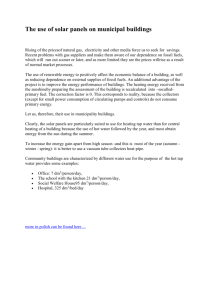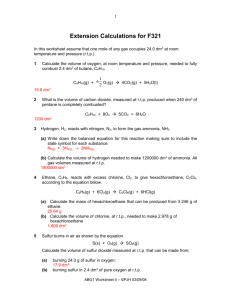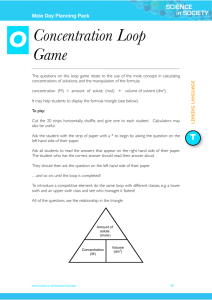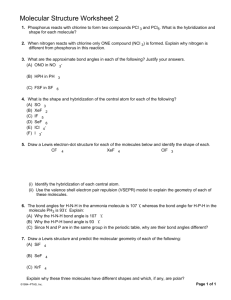XIChemistry(karachi board)
advertisement
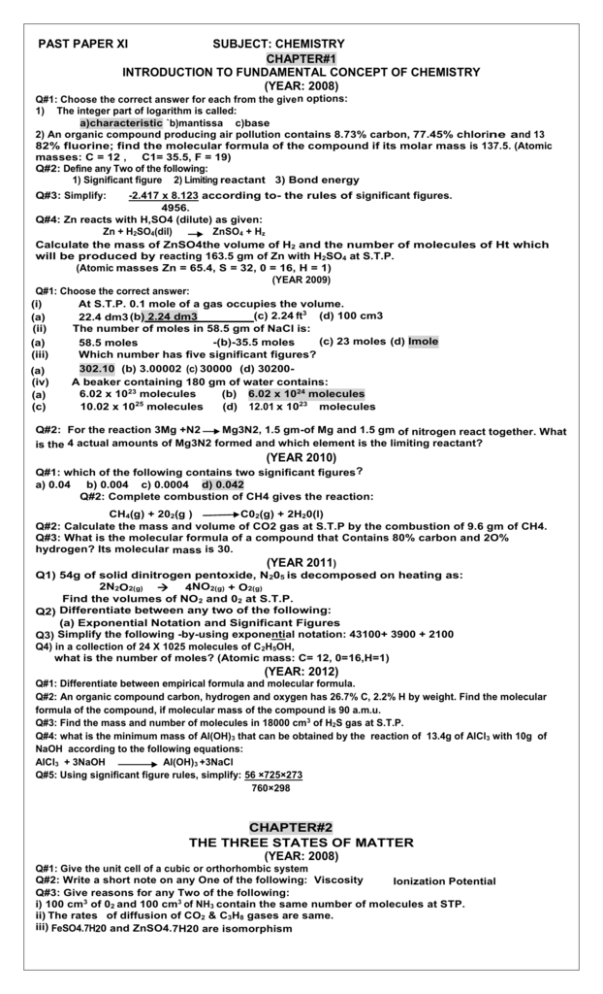
PAST PAPER XI SUBJECT: CHEMISTRY CHAPTER#1 INTRODUCTION TO FUNDAMENTAL CONCEPT OF CHEMISTRY (YEAR: 2008) Q#1: Choose the correct answer for each from the give n options: 1) The integer part of logarithm is called: a)characteristic `b)mantissa c)base 2) An organic compound producing air pollution contains 8.73% carbon, 77.45% chlorine and 13 82% fluorine; find the molecular formula of the compound if its molar mass is 137.5. (Atomic masses: C = 12 , C1= 35.5, F = 19) Q#2: Define any Two of the following: 1) Significant figure 2) Limiting reactant 3) Bond energy Q#3: Simplify: -2.417 x 8.123 according to- the rules of significant figures. 4956. Q#4: Zn reacts with H,SO4 (dilute) as given: Zn + H2SO4(dil) ZnSO4 + Hz Calculate the mass of ZnSO4the volume of H2 and the number of molecules of Ht which will be produced by reacting 163.5 gm of Zn with H2SO4 at S.T.P. (Atomic masses Zn = 65.4, S = 32, 0 = 16, H = 1) (YEAR 2009) Q#1: Choose the correct answer: (i) At S.T.P. 0.1 mole of a gas occupies the volume. (c) 2.24 ft3 (d) 100 cm3 (a) 22.4 dm3 (b) 2.24 dm3 (ii) The number of moles in 58.5 gm of NaCl is: (c) 23 moles (d) Imole -(b)-35.5 moles (a) 58.5 moles (iii) Which number has five significant figures? 302.10 (b) 3.00002 (c) 30000 (d) 30200(a) (iv) A beaker containing 180 gm of water contains: 6.02 x 1023 molecules (b) 6.02 x 1024 molecules (a) (c) 10.02 x 1025 molecules (d) 12.01 x 1023 molecules Q#2: For the reaction 3Mg +N2 Mg3N2, 1.5 gm-of Mg and 1.5 gm of nitrogen react together. What is the 4 actual amounts of Mg3N2 formed and which element is the limiting reactant? (YEAR 2010) Q#1: which of the following contains two significant figures ? a) 0.04 b) 0.004 c) 0.0004 d) 0.042 Q#2: Complete combustion of CH4 gives the reaction: CH4(g) + 202(g ) C02(g) + 2H20(l) Q#2: Calculate the mass and volume of CO2 gas at S.T.P by the combustion of 9.6 gm of CH4. Q#3: What is the molecular formula of a compound that Contains 80% carbon and 2O% hydrogen? Its molecular mass is 30. (YEAR 2011) Q1) 54g of solid dinitrogen pentoxide, N 205 is decomposed on heating as: 2N2O2(g) 4NO2(g) + O2(g) Find the volumes of NO 2 and 02 at S.T.P. Q2) Differentiate between any two of the following: (a) Exponential Notation and Significant Figures Q3) Simplify the following -by-using exponential notation: 43100+ 3900 + 2100 Q4) in a collection of 24 X 1025 molecules of C 2H5OH, what is the number of moles? (Atomic mass: C= 12, 0=16,H=1) (YEAR: 2012) Q#1: Differentiate between empirical formula and molecular formula. Q#2: An organic compound carbon, hydrogen and oxygen has 26.7% C, 2.2% H by weight. Find the molecular formula of the compound, if molecular mass of the compound is 90 a.m.u. Q#3: Find the mass and number of molecules in 18000 cm3 of H2S gas at S.T.P. Q#4: what is the minimum mass of Al(OH)3 that can be obtained by the reaction of 13.4g of AlCl 3 with 10g of NaOH according to the following equations: AlCl3 + 3NaOH Al(OH)3 +3NaCl Q#5: Using significant figure rules, simplify: 56 ×725×273 760×298 CHAPTER#2 THE THREE STATES OF MATTER (YEAR: 2008) Q#1: Give the unit cell of a cubic or orthorhombic system Q#2: Write a short note on any One of the following: Viscosity Ionization Potential Q#3: Give reasons for any Two of the following: i) 100 cm3 of 02 and 100 cm3 of NH3 contain the same number of molecules at STP. ii) The rates of diffusion of CO2 & C3H8 gases are same. iii) FeSO4.7H20 and ZnSO4.7H20 are isomorphism Q#4: What is an Ideal Gas? What are the causes of deviation of the real gases from the ideal behavior? Q#5: What are the defects in Rutherford's Atomic Model? Write the postulates of Bohr’s atomic theory. Q#6: In the following part one item is different from the other. Locate the item and give the reason for it: Carbon black, graphite, coke, charcoal' and F2, C12, I2 of water molecules through hydrogen bond Q#7:Association (Draw the diagram only] Q#8: Metallic bonds in the atomic crystals of metals. [Draw the diagram only) Q#9: Write the postulates of Kinetic Molecular Theory of gases. (YEAR: 2009) Q#1: A gas at zero Kelvin is: (a) Super cooled (b) freezes Q#2: One cm3 is equal to: (a) (c)liquefies (d) vanishes 10.3 dm3 (b) 100 dm3 (c) 1000 dm3 (d) 10 dm3 Q#3: The unit of viscosity is: a)millipoise (b) milligram (c) joule (d) ampere Q#4: Evaporation is a: a) Natural process b) physical process c)Cooling process d) chemical process Q#5: Calculate the value of R when the pressure is expressed in atmosphere and volume-in dm3. Q#6: Helium takes 5, seconds to effuse from a hole of 10dm3 containers. How 1ong would it take for oxygen to effuse from the same container at the same temperature and pressure? Q#7: Give reason: The liquids have capillary action. Q#8: Give a brief account of viscosity and surface tension in liquids. Q#9: Explain the causes of non-ideal behavior of gases especially at high pressures and low temperatures. Q#10: Name the crystal system which has the following axes and Name the crystal system which has the following axes and angle. (ii) a=b#c, a=p=y=90° (i)a=b=c,a=p=y=90° (iii)a≠b≠c,a=3=y=90° (iv) a = b ≠c, a = ( = 90°, y = 120° (YEAR 2010) Q#1: If a ≠b ≠ c and a = p = y =90°, then crystal structure is: (c) Orthorhombic (d) Triclinic (a) Cubic (b) Tetragonal Q#2: Which of the following has the same number of molecules at S.T.P.? (a) 1 dm3 of N2 and 02 (b) 500 cm3 of C12 and 02 3 100cm of CO2 and 02 (d) All of them (c) Q#3: The vapour pressure of water at 100°C is: (a) 760torr (B) 760atm (c) 7torr (d) 76 atm Q#4: The total pressure of a mixture of gases is the sum of the partial pressure of each gas present in the mixture. This is stated by: (a) Dalton (b) Charles (c) Graham (d) Boyle Q#5: Write a note on viscosity. Q#6: State and explain Graham’s law of diffusion of gases. Q#7: At certain temperature and pressure NH 3 diffuses 1.48 times more than HCl. If the density of NH3 is 0.66g/litre. Find the density of HCl. Q#8: The density of ice is less than that of water. Q#9: On heating sublime substances like iodine and camphor they directly change from solid to gas. Q#10 Differentiate between Crystalline solid and Amorphous solid. (YEAR 2011) Q1) An ideal gas obeys laws under gas this condition: * High pressure * All temperatures and pressure * High temperature * Low temperature Q2) This instrument is used to measure atmospheric pressure * Barometer * Calorimeter * Spectrometer * Voltmeter Q3) In S.I. system. the unit of pressure is: *kg/ms2 * kg/ms * kg/m * kg/m2s Q4) The volume of gas would theoretically be zero *0 K * 273 K * 273°C *0°C Q5) The internal resistance of a liquid is called: * Surface tension *viscosity * resistance * all of these Q6) this is an intensive property: * Density * Mass * Mole * Volume Q7) Differentiate between Isomorphism and Polymorphism Q8) Give reasons for any four of the following: (a) A liquid is less viscous at high temperature. (b) Water has higher B.P. than Hydrogen fluoride although Fluorine is more electronegative than Oxygen (c) Pressure cooker is used for rapid cooking. (d) Evaporation is a cooling process. (e) A freely falling drop of liquid is spherical Q9) Define the term:Extensive Properties Q10) what will be the shape of a unit cell if a = b = c and a = β = y = 90°? Q11) Define Hydrogen bonding.. Q12) Explain any one state of matter on the basis of Kinetic Theory. Q13) Explain why the process of diffusion occurs most rapidly in gases, less rapidly in liquids and very slowly in solids. Q14) No liquid ionic compounds are known but many of the known covalent compounds are liquids and some are gases. Account for these differences. (YEAR: 2012) Q#1: The process, in which a solid directly changes into vapors without passing through liquid phase is called: a) Evaporation b) sublimation c) condensation d)neutralization Q#2: on Kelvin scale, absolute zero is equal to: a) 273.16°C b) 0 °C c) 20k d) -273.6°C Q#3: The number of crystal system on the basis of unit cell is: a) 5 b) 6 c) 7 d) 8 Q#4: 3.01× 1023 molecules of oxygen gas at S.T.P occupy a volume of: a) 22.4dm3 b) 224dm3 c) 11.2dm3 d) 2.24dm3 Q#5: The value of R (gas constant), when pressure is expressed in N/m2 is: a) 0.0821dm3atmosphere K-1 b) 8.3143J.k-1mole c) 9.8 Joule K-1mole-1 d) 8.213dm3atmosphere k-1mole-1 Q#6: Real gases are nearer to identity at: a) High temperature and low pressures b) high temperature and high pressure c) Low temperatures and low pressures d) low temperatures and high pressure Q#7: Capillary action of liquids is due to: a) Viscosity b) surface tension c) density d) fluidity Q#8: Two solids having the same crystal structure are called: a) Isomorphous b) polymorphous c) isotopes d) allotropes Q#9: Give reasons of any four of the following: a) Ethyl alcohol (C2H5OH) has greater viscosity than diethyl ether (C2H5-O-C2H5) c) HF forms stronger bond than HI. e) A freely falling drop of liquid is spherical. Q#10: Derive general gas equation by combining gas laws. Q#11:1.40dm3 volume of a gas collected at a temperature of 27°C and pressure of 900 torr was found to have a mass 2.273g. Calculate the molecular mass of the gas. Q#12: Explain the following gas laws with the help of kinetic theory of gases .i) Boyle’s law ii) Charles law iii) Dalton’s law of partial pressures. PAST PAPER XI SUBJECT: CHEMISTRY CHAPTER#3 THE ATOMIC STRUCTURE (YEAR: 2008) Q#1: Bohr’s model of atom is contradicted by: a)Heisenberg's Uncertainty Principle b)Pauli’s Exclusion Principle c)planc k's Quantum Theory Q#2: Calculate the wave number of an electron when it jumps from an orbit n=5 to an orbit n =1 (RH = 109678 cm-1) Q#3: Distinguish between any One of the following: a)Continuous spectrum and Line spectrum b) Electro negativity and Electron affinity Q#4: Which principle is violated in the following configurations? * Is2 2s 2p5 * Is2 2s2 2p5 Q#5: Write the values of all quantum numbers for both the electrons of He atom. Q#6: In the following part one item is different from the other. Locate the item and give the reason for it. Aufbau, Thomson, Rutherford, Bohr. Q#7: Choose the correct answer: The total no. of neutrons in 12 Mg2+ is: a)10 b)12 c)24 (YEAR: 2010) Q#1: The n+1 value for 5d orbital is: (a) 4 (b). 5 (c) 6 (d) 7 Q#2: A radioactive substance emits three types of radiation. Write their names along with their properties. Q#3: Derive expressions for frequency (u) and wave number of energy emitted when an electron jumps from higher energy state (E2) to lower (E1) Q#4: write the electronic configuration of Na(Z=11) and B(Z =5). What are the values of n and l for the last subshell of each element? What are their shapes? (YEAR: 2011) Q#1: An orbital can have a maximum of: *2 electrons *6 electrons *8 electrons *32 electrons Q#2 The maximum number of unpaired electrons in 3d energy level is: *5 *6 *7 *8 Q#3: An electron is said to be excited when it: * loses energy * jumps to a lower orbit * jumps to a higher orbit * Enters the atom Q#4: Differentiate between Orbit and Orbital Q#5: a) What rules and principles are violated in the following electronic configurations?1s2, 2s3, 1s2,2p2 ,1s2,2s2, 2p6,3s2,3p6,3d4,4s3 rd (b)Bohr's radius is 0.529A°. Find the radius of the 3 orbit of Hydrogen atom. Q#6: (a) Calculate the wave number of spectral lines of hydrogen gas when the electron jumps from n = 4 to n = 2. (RH = 109, 678cm-1) Q#7: Write the correct sequence of the orbital’s for the electronic configuration according to (n + I) rule: 3d 4s 4p 4d 5s 5p Q#8: What are the assumptions of Bohr's Theory? (YEAR:2012) Q#1: No two electrons in an atom can have all the four Quantum no’s identical is the statement of: a) Pauli’s exclusion principle b) Hund’s rule c) aufbau principles d) (n+l) rule Q#2: The particle having a mass 1836 times that of the electron is: a) Neutron b) proton c) meson d) hyperon Q#3: On emission of alpha –particles 92U238 changes into: a) 90Th234 b) 88 Ra226 c) 84Po210 d) 91 Pa231 + Q#4: Na ion is smaller in size than Na atom. Q#5: Derive expression for the frequency & wave no of radiation when the electron jumps from higher (n2) to lower orbit (n1). Q#5: arrange the orbital’s in order of ascending energy according to (n+l rule): 3d, 4s, 4p, 4d, 5s, 6s, 5p. Q#6: What is the difference between Balmer and Lyman series? Q#7: Calculate the wave no of the line in the Lyman series when an electron jumps from 3 rd orbit to the 1st orbit (RH= 109678cm-1). Q#8: Write the electronic configuration of the following and also give the no of protons and electrons in each: (a) Cu(Z=29) (b)Mg+2 ( Z=12) (c)Cl-1 (z=17) Q#9: Give the experimental evidence for the presence of small positively charged nucleus containing most of the mass of the atom. Write also the weakness of this atomic model. Q#10: State Pauli’s exclusion principle and explain it by giving the example of helium atom. Q#11: Define radioactivity .describe the characteristics of alpha and beta particle ______________________________________________________________________________________________ CHAPTER#4 CHEMICAL BONDING (YEAR: 2008) Q#1: What is Hybridization? Discuss spa hybridization in CH 4. Q#2Do as directed in the following: I) Covalent bonds in ethyne (C 2H2).[draw the Lewis structure] II) Co-ordinate covalent bond in ammonium ion [Draw the Lewis structure] Q#3: Predict the geometrical shape of BeC12 or NH3 on the basis of Electron-pair Repulsion Theory. Q#4: Which of the following compounds have dipole moment? BF3, H2O, CO2, CCI4 Q#5: Choose the correct answer for each from the given options: i) _______________ Bonds are present in one molecule of ethane (C2H2). * four sigma two pi *two sigma four pi * five sigma one pi *none of these ii) The bond distance between carbon-carbon single bond is: * *1.20A 1.54A * 1.34A iii) In hydrogen halides _________possesses the largest ionic character: a)HF b)HCI c)HBr Q#6: Give scientific reason: Phosphorus combines with chlorine to form PCI 5 but it does not form PI5 with iodine. (YEAR 2009) Q#1: In ethane (C2H4) molecules, there are: (a) five sigma bonds and one pie bond (b) five sigma bonds (c) four sigma bonds and two pie bonds (d) None of these Q#2: Which of the compounds has sp hybridization? NH3 (b) C2H2 (c) C2H4 (d) H2O (a) Q#3: Draw cross and dot structures of C2H4 and CHC13. Q#4: Briefly explain dipole moment and mention its units. Q#5: Give reason CO2 is a non-polar compound. Q#6: Discuss the ionic character of a covalent bond. Q#7: Explain the shape of ethane (C2H4) on the basis of hybridization. Q#8: Explain-the-structure of NH3 on the basis of Electron-Pair Repulsion Theory (YEAR: 2010) Q#1: which bond is non polar? a) Cl – Cl b) N – Cl c) C – CI d) H – CI Q#2: The Sp2 hybrid orbitals are: a) non-planar b) co-planar c) linear d)none of these Q#3: Write the ground state and excited state configuration of carbon atom. Q#4: Explain sp3-hybridization in carbon in detail. Q#5: Explain the structure of BF3 and H2O on the basis of Electron-pair Repulsion Model. (YEAR:2011) Q#1: The angle between Sp orbital is: * 120 * 1800 * 109.5° * 107.5° Q#2: The single bond in a covalent molecule is called: * Pi-Bond * Sigma Bond * Co-ordinate Covalent Bond * none of these Q#3: Define orbital Hybridization and discuss sp3 Hybridization. Q#4: Predict the shapes of the following molecules on the basis of electron pair repulsion b) C2H4 theory: a)H2O (YEAR: 2012) Q#1: What is an ionic bond? Write the formation of NaCl solid from Na atom and Cl atom along With energy changes. Q#2: Explain Sp3 hybridization in carbon in detail. Q#3: Explain the structure of BF3 and H2O on the basis of ELECTRON PAIR REPULSION MODEL. Q#4: Draw cross and dot product. Draw structures of C 2H4 and CHCl3. Q#5: Briefly explain dipole moment and mention its units. Q#6: What is hybridization? Discuss Sp3 hybridization in CH4. Q#7: Predict the shapes of following molecules on the basis of ELECTRON PAIR REPULSION MODEL. a) NH3 b) BeCl2 Q#8:_____ bonds are present in one molecule of ethene. a) Four sigma two pie b) two sigma four pie c) 5 sigma one pie Q#9: The bond distance between carbon carbon single bond is ________. a) 1.54 A° b) 1.34 A° c) 1.20 A° Q#10: In hydrogen halides_________ possesses the largest ionic character. a) HF b) HCl c) HBr Q#11: Which of the following compounds have SP2 hybridization? BEST OF LUCK CHAPTER#5 ENERGETICS OF CHEMICAL REACTIONS (YEAR: 2008) Q#1: State and explain Hess's Law of Constant Heat Summation. Give its application. Q#2:Calculate the heat of formation of N2O4 from the following data: (i) 2NO2 (g) N204 (g) ∆H =? (ii) 1/2 N2(s) + O2(g) N2 (g) ∆H = +33.95KJ / mole (iii) N2(g) + 202(g) N2O4(9) ∆H = +9.3KJ / mole Q#3: Write True or False for the following: 1joule = 4.184 calories (F) J*-Work is a state function. (YEAR: 2009) Q#1: Calculate the heat of formation of propane (AH) from the given reaction. 3C(s) + 4H2 (g) 4 C3H8 (g): ∆H =? (a) C(s) + 02(g) 4 C02(g) ∆H =-394KJ / mole (b) H2(g)+ 1/202(g) H2O(l) ∆H = -286KJ / mole (c) C3H8)0) +50(g) - 3C02(g)+4H20(,) ∆H -2200KJ(mole Q#2: State the first Law of Thermodynamics. Derive the expression ∆H=∆E +P∆V (YEAR 2010) Q#1: The heat content of the system is called: a) Internal energy b) enthalpy c) Entropy d) potential energy Q#2:a) Define standard heat of formation. b) Calculate the standard heat of formation of the methyl alcohol from its elements from the following data: i) C +2H2 +1/2 O2 CH3OH ∆Hf =? ii) C +O2 CO2 ∆H=-394KJ/mole iii)H2 +1/2O2 H2 O ∆H=-286KJ/mole iv)CH3OH +3/2O2 CO2 +2H2O ∆H=-726KJ/mole Q#3: Differentiate between endothermic and exothermic reaction. (YEAR: 2011) NO QUESTION OF CHAPTER#5 (YEAR: 2012) Q#1: Define enthalpy and internal energy. Q#2: calculate ∆H for the reaction: 3Mg +N2 Mg3N2 ∆H=? Given: (1) Mg + N2 Mg3N2 +3H2 ∆H= -371 KJ (2) ½ N2 +3/2H2 NH3 ∆H=-46KJ Q#3: A system absorbs 2000 J of heat from the surroundings and doe 1200 J of work on the surroundings by expansion. Find the internal energy change (∆E) of the system. Q#4: State and explain First law of thermodynamics .Prove qp=∆H and W=P∆V. CHAPTER#6 CHEMICAL EQUILIBRIUM (YEAR:2008) Q#1:State the Law of Mass Action and derive the equilibrium constant for aA + bB <==='cC + dD Q#2:State Le Chatelier's Principle. For the gaseous equilibrium 2N0(g) +OZ(g) 2N02(g) ∆H = -ve. Predict only the directions in which the reaction will proceed after the following changes are brought about at equilibrium: i) Increasing the concentration of NO. (ii) Decreasing the concentration of NO2 (iii) Increasing the temperature. (iv)Increasing the pressure. Q#3: In a reaction A + B <===> 2C, 7moles / dm3 of A and 7moles / dm3 of B were mixed and allowed to attain equilibrium. If K, = 2.25, find out the concentration of A, B and C at equilibrium state. Q#4: What is Solubility Product (KSP)•The solubility of AgCl at 25 °C is 1.4 x 10-3 gm/ dm3.What is its solubility product? (Atomic masses: Ag =108, Cl = 35.5) (YEAR: 2009) Pb2+ 2I- At 25°C the solubility of PbI2=0.63x10-3 mole/dm3; Q#1: The given reaction is PbI2 find the value of KSP and express its unit. Q#2: State and explain Le Chatelier's Principle and write down its industrial application Q#3: Explain Common-Ion Effect related to Kp value (YEAR 2010) Q#1: The solubility product (Ksp) of AgCI is 1x 10.10 mo le2dm6.its precipitation occurs if the product of ionic concentration is: a) Less than KSP. b) Greater than KSP. c) Equal to KSP. (d) Twice KSp. Q#2: The active masses of reacting substances mean: a) mol/dm3 b) gm/dm3 c) gm/cm3 d) mole/cm3 Q#3: Which of the reactions has the same value of Kc and Kp? a) N2+3H2 <======> 2NH3 b) H2+ I2 <======> 2HI c) PCl5 <======> PCl3 +Cl2 d) 2 SO2 + O2 <======> 2SO3 Q#4: What are the applications of the law of equilibrium? Explain with examples. Q#5: What is meant by Common-Ion Effect? Discuss its application in the precipitation of the second group of basic radicals in qualitative salt analysis. Q#6Define Solubility and Solubility Product. Write the solubility product (KSP) expressions of the following sparingly soluble salts along with their units: (i) CaCO3 (ii) Mg(OH)2 (YEAR 2011) Q#1 If Kc its very small: * reverse reaction will occur * forward reaction will take place * more products will be formed * none of these (YEAR: 2012) Q#1: For the reaction 2NH3 <======> N2 +3H2, the relationship between KC and KP is: a) Kp =Kc b) Kp>kc c) Kp< Kc d) Kp<Kc Q#2: The dipole moment of Cl2 molecule is: a) 0.00D b) 1.03 D c) 1.85D d) 1.67 D Q#3: The equilibrium constant expression for a gaseous equilibrium is : K c= [ NO]4[H2O] [NH3]4[O2]5 Q#4: Discuss the effect of increase in temperature and pressure on the following systems at equilibrium: a) N2 +3H2 NH3 +heat b) N2 + O2 2 NO Q#5: The solubility of calcium oxalate is 0.0016gm/dm3 at 25°C .Find the solubility product of calcium oxalate. CaC2O4 Ca+2 +C2O4-2 CHAPTER#7 SOLUTIONS AND ELECTROLYTES (YEAR: 2008) Q#1) If pH of a solution is zero, the nature of solution will be a) acidic b) basic c) amphoteric Q#2Which one is more concentrated 1Molar NaOH or I Molal NaOH aqueous solution? Explain it Q#3: Choose the correct answer for each from the given options: i) KCI is a/an _______ salt.(normal, acidic, basic) ii) The colour of the universal indicator in a neutral solution is_________(green, purple, red) Q#4:Differentiate between any One of the following:'*Hydration and Hydrolysis* Sigma bond and pi Q#5: Write a short note on any One of the following: (i) pH (ii) ' Arrhenius Theory of Ionization Q#6: For the reaction NH3 + H20 <==> NH4' + OH’, point out Acid, conjugate base and conjugate acid, according to bronsted lowry theory and five reasons. Q#7: What is Electrode Potential? How is electrode potential of Zn determined experimentally? Q#8: Find the oxidation number of H in H2 and 0 in OF2 Q#9: Balance the following equation by Ion-electron Method. Mn04' + Fe2* Mn2' + Fe3' (acidic medium) (YEAR:2009) Q#1: If 200 cm3 of IM solution is diluted up to 2000 cm3, its molarity would be: (a) 10M (b) 0.2M (c) 0.1M (d) 1M Q#2: The oxidation number of S in H2SO4 is: (a) 6' (b) 2" (c) 4' (d) Zero Q#3:What is the PoH of a solution whose pH is 8? (a) 6 (b) 10 (c) 4 Q#4: Which of the following is the example of oxidation? (A) M+3 M+2 (b) M+2 M+3 © 2Be4 + 2He 4 C612+ on1 (d) none of these Q#5: Write down the postulates of the Arrhenius Theory of Ionization. Q#6: (i) find the oxidation number of oxygen in OF2. Fe+3 +Mn+2 + H2O. (ii)Balance the equation: Fe +2 + MnO4-1 + H+ (d) 2 (YEAR 2010) Q#1: In metals conduction is due to the: (A) Movement of ions (b) movement of electrons (c) Movement of protons (d) movement of atoms Q#2: An electrochemical cell is based upon: a) acid base reaction b) redox reaction c) oxidation reaction d)reduction reaction Q#3: Define Electrolysis. Name the two parts of the Redox reaction that occurs in the electrolysis of molten sodium chloride and state where each part occur. Q#4: Give scientific reason. The reactions between ionic compounds are fast. Q#5: Differentiate between hydration and hydrolysis. Q#6: Balance any One of the following equations by Ion-Electron method. (i)Mn04- +Cl-1 Mn+2 +C12 (acidic medium) (ii)Mn04-1 +SO3-2 Mn04-2 +SO4-2 (basic medium) Q#7: Define pH and pOH. What is the mathematical relationship between pH and pOH of an aqueous solution? Q#8: What is the H+ and OH- ion concentration of a solution having pH equal to 7.86? Q#9: Explain a Buffer solution with an example and write its properties (YEAR 2011) Q#1:In electrolytic cell, cathode is: * Negative * Positive * Neutral * none of these Q#2: The oxidation number of oxygen in hydrogen peroxide is: c) +1 d)-1 a) + 2 b) -2 Q#3: The Range Of pH is: * 1-10 * 0-20 * 1-100 * 0-14 Q#4: What is neutralization? Give the examples of normal, acidic and basic salts. Q#5: Define the following terms: (a)Extensive Properties (b) Enthalpy (c) Molarity (d) Common Ion Effect Q#6: How is buffer solution prepare#?Q#7: Find the oxidation number of: a)Cr in K2Cr2O7 b)S in Na2S2O3 (YEAR: 2012) Q#1: The colour of universal indicator in neutral solution is: a) Red b) green c) blue d) pink Q#2: In electrolytic cell, the anode is the electrode where: a) Oxidation occurs b) reduction occurs c) both oxidation and reduction occurs Q#3: The number of gram moles of solute present in 1 dm3 of solute is called: a) Normality b) molarity c) mole fraction d) molality Q#4: Balance the following equations by Ion electron method: a) Cr(OH)3 + SO4-2 CrO4-2 + SO3-2 (BASIC MEDIUM) b)MnO4- + C2O4-2 Mn+2 + CO2 ( ACIDIC MEDIUM) Q#5: Define standard electrode potential .How is the standard electrode potential of zinc determined? Q#6: Define electrolysis .write the main postulates of Arrhenius Theory of Ionization. CHAPTER#8 INTRODUCTION TO CHEMICAL KINETICS (YEAR: 2008) Q#1:A negative catalyst decreases the rate of reaction Q#2: What is rate of reaction? Describe how the rate of the following chemical reaction is determined experimentally CH3COOCH3 + H2O CH3COOH +CH30H Q#3: How is rate of reaction influenced by the surface area? of the reactant Q#4: Write the rate expressions for H2 + C12 2HCI and N205 2NO2 +1/202 Q#5: For the chemical reaction F2 + 2CIO2 2FC102 Calculate the rate constant when initial concentration of F2 is 0.1 mole/dm3, of Cl02 is 0.01 moles / dm3 and the rate of reaction is 1.2 x 10'3 mole / dm3 sec. (YEAR: 2009) Q#1: For the given reaction A + B data: S.No 1 2 3 products, determine the order of reaction from the following A(mol/dm3) 0.1 0.2 0.1 B(mol/dm3) 0.1 0.1 0.3 RATE(molsec-1) 1x10-3 4x10-3 3x10-3 (YEAR 2010) Q#1: Consider the reaction A+ B C and answer the following. a) Write the rate expression for the above reaction. What are the units of the rate of reaction? b) Will the specific rate constant (K) increase, decrease or remain unchanged if the concentration of A and B is doubles? c) The rate constant for the decomposition of NO2 in the equation 2NO2 --► 2NO + 02 is 1.8 x 10'3 dm3/mole.S. What is the initial rate when the initial concentration of NO2 is 0.75M? What is the rate constant when the initial concentration of NO 2 is doubled? Q#2: What are the factors which affect the rate of reaction? Explain any two factors. Q#3: Give scientific reason Milk gets sour sooner in summer than in winter. Q#4: The change in concentration of reacting substance in a unit time is called: (a) Rate ofreaction (b) rate constant (c) Rate law velocity constant (d ) Q#5: The addition of a catalyst to a reaction changes: (a) Internal energy (b) Activation energy (c) Threshold energy (d) Gibb's free energy (YEAR 2011) Q#1: Reactions with high activation energy: *are slow *are fast *are moderate *do not occur Q#2: Define specific rate constant. Q#3: Define and explain activation energy. Q#4: Write notes on any two of the following: * Slow reactions *Fast reactions Moderate reactions * Positive catalyst * Q#5: Discuss the Effect of light on the rate of reaction. (YEAR: 2012) Q#1: Give reason: Milk sours more rapidly in summer than in winter. Q#2: the rate constant for the reaction 2NO 2NO +O 2 is 1.8 ×10-8 dm3mol-1sec-1. If the initial concentration of NO2 is 2M, what is the rate of reaction? Q#3: Name the physical methods along with the observed physical properties for determining the rate of reaction. Describe the method for determining the rate of reaction by physical or chemical means.



